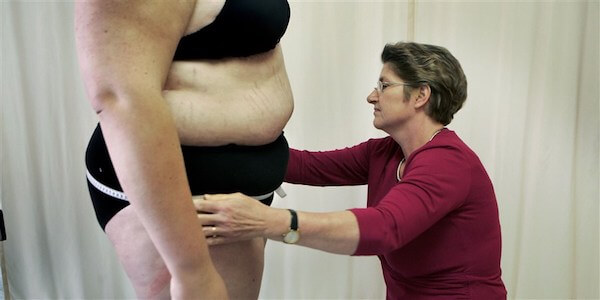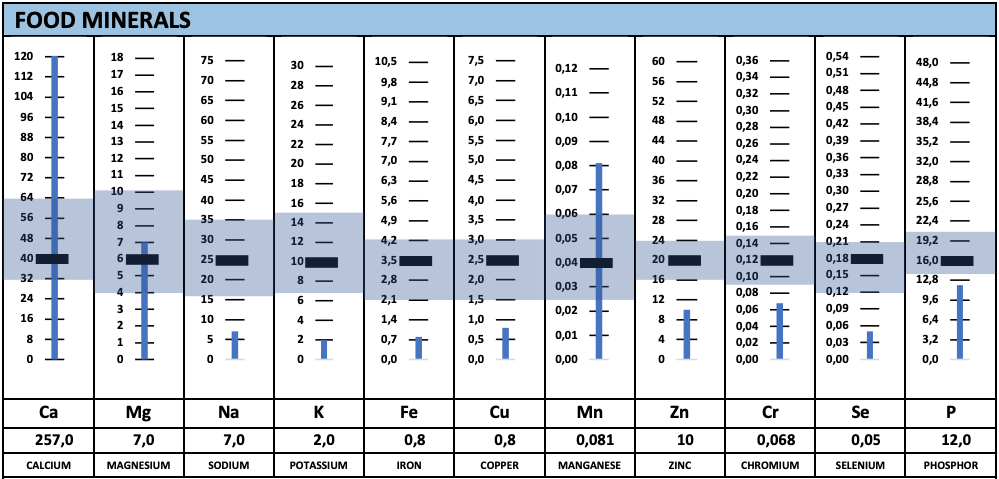Diagnosis of regulatory systems is ideally suited to map important parameters related to Metabolic Syndrome. It concerns a 35-year-old woman with a BMI of 35, with, among other things, poor energy, and anxiety and panic disorders.
The Hair Tissue Mineral Analysis (HTMA) shows the following picture:
In view of the high BMI and the high Ca/Mg ratio (lifestyle or carbohydrate ratio), an additional Insulin-Resistance Combi analysis is an obvious step. If only to obtain an accurate picture in measure and number (HOMA2 index) of the degree of insulin resistance, which is probably real.
The following data were obtained:
| Measured values | Data | Reference |
| HS-CRP | 1,82 | < 1,0 |
| ox-LDL antibodies | 456 | < 800 |
| Glucose (fasting) | 6,8 | 4,5-6,5 |
| Insuline (fasting) | 358 | 15-90 |
| C-Peptide (fasting) | 1,57 | 0,25-0,90 |
| Homocysteïne | 6 | 6 |
The University of Oxford developed the HOMA index to provide a numerical indication of the presence and extent of insulin resistance. The index can be calculated on both the Glucose/C-Peptide values and the Glucose/Insulin value. The first is usually the most reliable for non-diabetics, unless they have clearly too high insulin production. In people with type 2 diabetes who inject insulin, you can only determine the index using the Glucose/C-Peptide formula, because the measured insulin blood value is not equal to the own insulin production.
The HOMA2 index
| Glucose / C Peptide | Glucose / Insuline | ||
| Glucose | 6,8 mmol/l | Glucose | 6,8 mol/l |
| C-Peptide | 1,57 nmol/l | Insuline | 358 pmol/l |
| HOMA2 %B | 129,8 | HOMA2 %B | 200,7 |
| HOMA2 %S | 26,4 | HOMA2 %S | 15 |
| HOMA 2 IR | 3,79 | HOMA 2 IR | 6,67 |
A HOMA2 IR < 1 is regarded as optimal. A healthy range is 0,5-1,4.
HOMA2 IR > 1,9 is an early Insulin Resistance.
HOMA2 IR > 2,9 is a significant Insulin Resistance.
This patient is clearly above that with a score of 3.79. Although the fasting morning glucose is a borderline case for the GP, we have to conclude on the basis of the HOMA indices that this woman is well on the way to developing type 2 diabetes mellitus.
The elevated HS-CRP indicates the presence of low-grade inflammation, which is commonly seen in insulin resistance. The level of Antibodies oxidized LDL is good (biomarker for the risk of cardiovascular disease) and the Homocysteine also scores well.
The Manganese intoxication in the HTMA also requires attention.
An increased concentration of manganese in the hair indicates that there is too high a concentration of biologically unusable manganese in the body. This may well mean that at the same time there is a serious shortage of the biologically useful form. We often see the increased manganese values in the Hair Mineral Analysis (HTMA) as a possible indicator for a Glyphosate (pesticide) load and the resulting disturbance in the Glycine metabolism. It can therefore certainly be advisable to also do a Glyphosate urine test here to see whether there is a Glyphosate load in the current diet and living conditions.
Finally, the Ca/K ratio is also strongly increased. This ratio, which is also called the thyroid ratio, at least indicates that the mitochondrial energy metabolism as a result of the thyroid metabolism (HPA axis) is seriously underfunction.
Now that the picture is complete, we see how important a thorough system diagnosis is. Now it is time to start a personal intervention process.








